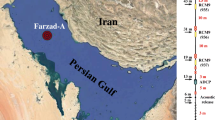Abstract
In this study, we developed the first linear Joint North Sea Wave Project (JONSWAP) spectrum (JS), which involves a transformation from the JS solution to the natural logarithmic scale. This transformation is convenient for defining the least squares function in terms of the scale and shape parameters. We identified these two wind-dependent parameters to better understand the wind effect on surface waves. Due to its efficiency and high-resolution, we employed the airborne Light Detection and Ranging (LIDAR) system for our measurements. Due to the lack of actual data, we simulated ocean waves in the MATLAB environment, which can be easily translated into industrial programming language. We utilized the Longuet-Higgin (LH) random-phase method to generate the time series of wave records and used the fast Fourier transform (FFT) technique to compute the power spectra density. After validating these procedures, we identified the JS parameters by minimizing the mean-square error of the target spectrum to that of the estimated spectrum obtained by FFT. We determined that the estimation error is relative to the amount of available wave record data. Finally, we found the inverse computation of wind factors (wind speed and wind fetch length) to be robust and sufficiently precise for wave forecasting.
Similar content being viewed by others
References
Bermont, M. R., Horwood, R., Thurley, W. F., and Baker, J., 2006. Shallow angle wave profiling LIDAR. Journal of Atmospheric and Oceanic Technology, 24: 1150–1156.
Blenkinsopp, C. E., Turner, I. L., Allis, M. J., Peirson, W. L., and Garden, L. E., 2012. Application of LIDAR technology for measurement of time-varying free-surface profiles in a laboratory wave flume. Coastal Engineering Journal, 68: 1–5.
Cooley, J. W., and Tukey, J. W., 1965. An algorithm for the machine calculation of complex Fourier series. Mathematics of Computation, 19: 297–301.
Dean, R. G., and Dalrymple, R. A., 1984. Water Wave Mechanics for Engineers and Scientists. Prentice-Hall Inc., Upper Saddle River, NJ, USA, 72pp.
Hasselmann, K., 1973. Measurement of wind wave growth and swell decay during the Joint North Sea Wave Project (JONSWAP). Deutsche Hydrographische Zeitschrift, A (8): 95.
Hasselmann, K., Ross, D. B., Muller, P., and Sell, W., 1976. A parametric wave prediction model. Journal of Physical Oceanography, 6: 200–228.
Huang, W. M., Shen, C. X., Gill, E. W., and Horstmann, J., 2016. Surface current measurements using X Band marine radar with vertical polarization. IEEE Transactions on Geoscience and Remote Sensing, 54: 2988–2997.
Irish, J. L., and Lillycrop, A. J., 1999. Scanning laser mapping of the coastal zone: The SHOALS system. ISPRS Journal of photogrammetry and Remote Sensing, 54: 123–129.
Mitsuyasu, H., Tasai, F., Suhara, T., Mizuno, S., Ohkusu, M., Honda, T., and Rikiishi, K., 1979. Observation of the power spectrum of ocean waves using a cloverleaf buoy. Journal of Physical Oceanography, 10: 286–296.
Naderi, M., and Patzold, M., 2015. Design and analysis of a one-dimensional sea surface simulator using the sum-of-sinusoids principle. In: OCEANS 2015–MTS/IEEE Washington. Washington DC, 19–22.
Nouguier, F., Grilli, S. T., and Gurin, C. A., 2014. Nonlinear Ocean wave reconstruction algorithms based on simulated spatiotemporal data acquired by a flash LIDAR camera. IEEE Transactions on Geoscience and Remote Sensing, 52: 1761–1771.
Synder, R. L., 1974. A field study of wave induced pressure fluctuation above surface gravity waves. Journal of Marine Research, 32: 491–531.
Turner, I. L., Harley, M. D., and Drummond, C. D., 2016. UAVs for coastal surveying. Coastal Engineering, 114: 19–24.
Wang, C. K., and Phipot, W. D., 2006. Using airborne bathymetric LIDAR to detect bottom type variation in shallow waters. Remote Sensing of Environment, 106: 123–135.
Acknowledgements
This work is supported by the Scientific Instruments Development Program of NSFC (No. 615278010), and the National Key Basic Research Program of China (973 program) under grant No. 2014CB845301/2/3.
Author information
Authors and Affiliations
Corresponding author
Rights and permissions
About this article
Cite this article
Yu, Y., Pei, H. & Xu, C. Parameter identification of JONSWAP spectrum acquired by airborne LIDAR. J. Ocean Univ. China 16, 998–1002 (2017). https://doi.org/10.1007/s11802-017-3271-2
Received:
Revised:
Accepted:
Published:
Issue Date:
DOI: https://doi.org/10.1007/s11802-017-3271-2




